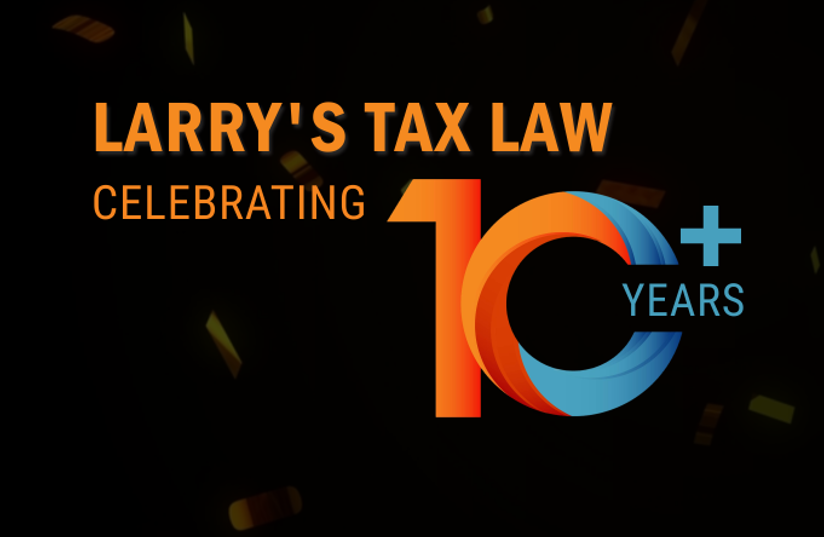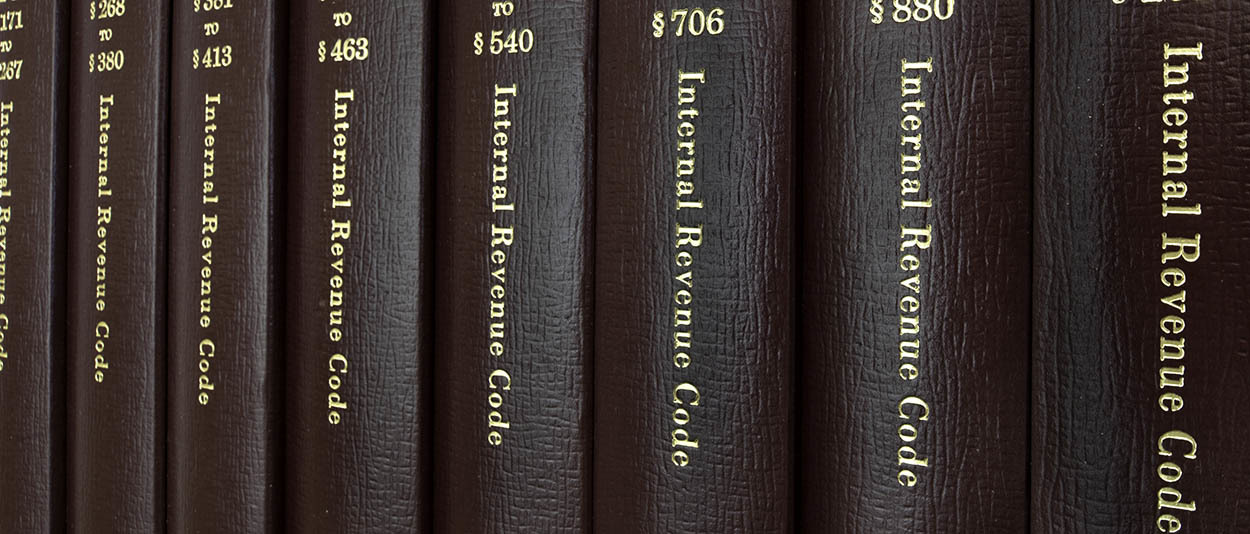- Posts by Larry Brant
 Principal
PrincipalLarry is Chair of the Foster Garvey Tax & Benefits practice group. He is licensed to practice in Oregon and Washington. Larry's practice focuses on assisting public and private companies, partnerships, and high-net-worth ...
Overview
 In the S corporation arena, tax advisors and taxpayers generally do not focus a lot of attention on the S corporation shareholder eligibility rules other than at the time the S election is made. As we dive into shareholder eligibility rules in this Part VIII of my multi-part series on Subchapter S, it should become apparent that the eligibility rules can be complex and require that S corporations and their shareholders keep a close eye on shareholder eligibility after the S election is made.
In the S corporation arena, tax advisors and taxpayers generally do not focus a lot of attention on the S corporation shareholder eligibility rules other than at the time the S election is made. As we dive into shareholder eligibility rules in this Part VIII of my multi-part series on Subchapter S, it should become apparent that the eligibility rules can be complex and require that S corporations and their shareholders keep a close eye on shareholder eligibility after the S election is made.
Instances where S corporations and their shareholders may find the S election in peril for violating the shareholder eligibility rules include: (i) when a shareholder sells or otherwise transfers shares to a person or entity other than an existing eligible shareholder; (ii) when the corporation issues shares to a new shareholder; and (iii) when an existing shareholder transfers shares to a vehicle intended to be used for estate planning and/or creditor protection purposes. Failure to pay close attention to the eligibility rules can result in disastrous consequences to the S corporation and its shareholders.
 As reported last week, opponents of the Washington state capital gains tax, after ultimately losing in the courts to have the legislation stricken as unconstitutional, decided to take the matter to the voters. They have proposed a ballot measure which if successful, among other things, will repeal the tax.
As reported last week, opponents of the Washington state capital gains tax, after ultimately losing in the courts to have the legislation stricken as unconstitutional, decided to take the matter to the voters. They have proposed a ballot measure which if successful, among other things, will repeal the tax.
As part of the presentation of the ballot measure in the voters’ pamphlet, the State of Washington election officials recently announced that the explanation of the ballot measure must include a disclosure of the revenue impact its passage would have on the state’s revenue – a drop of roughly $1 billion per year. Proponents of the ballot measure promptly filed a lawsuit in the Superior Court of Washington for Thurston County (“Court”) to block the inclusion of the revenue impact in the voter packets. A hearing in the case occurred on June 7, 2024.
Judge Allyson Zipp, appointed to the Court by Governor Jay Inslee in 2021, presided over the case. The oral arguments were interesting.
I have reported in several prior blog posts the significant events impacting the newly enacted Washington state capital gains tax. The turbulent ride of this legislation continues!
The Colorful Journey
 The colorful journey of the Washington capital gains tax started with Senate Bill 5096 ("SB 5096"). The bill was originally introduced to the Washington State Senate on January 6, 2021. It was passed by the Senate on March 6, 2021, after a hearing in the Senate Committee on Ways and Means, three readings and some floor amendments. The bill's passage margin in the Senate was narrow, receiving 25 affirmative votes and 24 negative votes.
The colorful journey of the Washington capital gains tax started with Senate Bill 5096 ("SB 5096"). The bill was originally introduced to the Washington State Senate on January 6, 2021. It was passed by the Senate on March 6, 2021, after a hearing in the Senate Committee on Ways and Means, three readings and some floor amendments. The bill's passage margin in the Senate was narrow, receiving 25 affirmative votes and 24 negative votes.
SB 5096 continued its journey to the Washington State House of Representatives, where the bill was introduced on March 9, 2021. After three readings and two separate votes, as well as some amendments, the bill was passed in the House on April 21, 2021. As was the case in the Senate, its passage margin in the House was narrow, receiving 52 affirmative votes and 46 negative votes.
Overview
 In the S corporation arena, tax advisors generally do not focus much attention on unreasonable compensation. As we delve into the issue in this Part VII of my multi-part series on Subchapter S, it will become apparent that reasonableness of compensation in the S corporation setting is important. Failure to pay attention to the issue can place S corporations and their shareholders in peril.
In the S corporation arena, tax advisors generally do not focus much attention on unreasonable compensation. As we delve into the issue in this Part VII of my multi-part series on Subchapter S, it will become apparent that reasonableness of compensation in the S corporation setting is important. Failure to pay attention to the issue can place S corporations and their shareholders in peril.
Closely held C corporations have historically been incentivized to distribute profits as compensation to shareholder employees. A corporation is allowed, under IRC § 162(a)(1), to deduct “a reasonable allowance for salaries or other compensation for personal services actually rendered.” There is, however, no corresponding deduction for dividend distributions, which end up being taxed twice: once at the corporate level upon earning the income that funds the dividend, and again at the shareholder level upon receipt of the dividend. Consequently, treating distributions of profits as compensation for services rendered could significantly reduce a corporation’s tax liability.
Overview
 I am taking a break from my multi-part blog series, A Journey Through Subchapter S / A Review of the Not So Obvious & The Traps That Exist For The Unwary, to provide another update on the Corporate Transparency Act (“CTA”). The CTA continues to get a lot of media attention as there have been judicial and legislative efforts to obtain its repeal or to strike it down as unconstitutional.
I am taking a break from my multi-part blog series, A Journey Through Subchapter S / A Review of the Not So Obvious & The Traps That Exist For The Unwary, to provide another update on the Corporate Transparency Act (“CTA”). The CTA continues to get a lot of media attention as there have been judicial and legislative efforts to obtain its repeal or to strike it down as unconstitutional.
As reported on June 7, 2023, the CTA is a new federal law that requires most U.S.-based companies, including corporations, partnerships and limited liability companies, to report information regarding their “beneficial owners” to the federal government through the Financial Crimes Enforcement Network (“FinCEN”) and a new FinCEN IT system known as the Beneficial Ownership Secure System (“BOSS”). Lawmakers enacted the CTA to help the government combat money laundering, financing of terrorist activities, tax fraud and other illegal activities.
 This sixth installment of my multi-part series on Subchapter S is focused on the revocation of an S corporation election.[1] While the rules relating to revocation are fairly straightforward, there are a few nuances that may create traps for unwary taxpayers and their tax advisers.
This sixth installment of my multi-part series on Subchapter S is focused on the revocation of an S corporation election.[1] While the rules relating to revocation are fairly straightforward, there are a few nuances that may create traps for unwary taxpayers and their tax advisers.
Background
An S election may be revoked with the consent of greater than 50 percent of the shares held on the date of revocation.[2]
Revocation of an S election does not require the Secretary’s consent. Rather, to revoke an S election, the corporation simply must file a written statement with the Service Center where it files its IRS Form 1120S. The statement must include:
 I have been sharing knowledge with tax professionals through writing papers and articles, and presenting at tax conferences for almost 40 years. On March 11, 2013, with the encouragement of others, I entered the digital publishing age, embarking on a new journey with the launch of Larry’s Tax Law. At that time, I was unsure where the journey would take me. My goal was simple and straightforward – to continue sharing knowledge about highly relevant and interesting tax law matters and developments with accountants, tax attorneys and other tax professionals.
I have been sharing knowledge with tax professionals through writing papers and articles, and presenting at tax conferences for almost 40 years. On March 11, 2013, with the encouragement of others, I entered the digital publishing age, embarking on a new journey with the launch of Larry’s Tax Law. At that time, I was unsure where the journey would take me. My goal was simple and straightforward – to continue sharing knowledge about highly relevant and interesting tax law matters and developments with accountants, tax attorneys and other tax professionals.
Larry’s Tax Law is now more than a decade old. To be more precise (as we tax professionals tend to be), the blog is now 11 years, 1 month and 14 days old. We have been sharing knowledge with tax professionals in this digital format for more than 4,063 days!
 This fifth installment of my multi-part series on Subchapter S is focused on married individuals who own shares of an S corporation. While the rules relating to shareholder eligibility seem straightforward, their application relative to spouses may create traps for unwary taxpayers and their tax advisers.
This fifth installment of my multi-part series on Subchapter S is focused on married individuals who own shares of an S corporation. While the rules relating to shareholder eligibility seem straightforward, their application relative to spouses may create traps for unwary taxpayers and their tax advisers.
BACKGROUND
Number of Shareholders Limitation
Prior to 1996, an S corporation could have no more than 35 shareholders. The Small Business Job Protection Act of 1996 (“SBJPA”) amended Code Section 1361(b)(1)(A), increasing the maximum number of permitted shareholders of an S corporation to 75. In 2004, Congress enacted the American Jobs Creation Act (“AJCA”). The AJCA further amended Code Section 1361(b)(1)(A), increasing the maximum number of permitted shareholders of an S corporation to 100. This change was effective for tax years beginning in 2005. Today, the maximum number of permitted shareholders of an S corporation remains at 100.
 This fourth installment of my multi-part series on Subchapter S is focused on suspended losses of an S corporation. While the rules seem straightforward, their application can be tricky, especially given legislative changes made in recent years.
This fourth installment of my multi-part series on Subchapter S is focused on suspended losses of an S corporation. While the rules seem straightforward, their application can be tricky, especially given legislative changes made in recent years.
Background
In general, S corporation shareholders, like the owners of entities taxed as partnerships, are allocated their share of the entity’s losses for the taxable year. A number of rules, however, may limit the ability of the owners to deduct these losses.
 I am taking a short break between the third and fourth installment of my multi-part series on Subchapter S. Before I publish the fourth installment on that topic, my colleague Steven Nofziger and I want to alert our readers to some recent developments relative to the Corporate Transparency Act (“CTA”).
I am taking a short break between the third and fourth installment of my multi-part series on Subchapter S. Before I publish the fourth installment on that topic, my colleague Steven Nofziger and I want to alert our readers to some recent developments relative to the Corporate Transparency Act (“CTA”).
CTA
As previously reported, the CTA is a new federal law that requires most U.S.-based companies, including corporations, partnerships and limited liability companies, to report information regarding their “beneficial owners” to the federal government through the Financial Crimes Enforcement Network (“FinCEN”) and a new FinCEN IT system known as the Beneficial Ownership Secure System (“BOSS”). The intent of the CTA and the reporting to FinCEN is to combat money laundering, tax fraud and other illegal activities.
 Larry J. Brant
Larry J. Brant
Editor
Larry J. Brant is a Shareholder and the Chair of the Tax & Benefits practice group at Foster Garvey, a law firm based out of the Pacific Northwest, with offices in Seattle, Washington; Portland, Oregon; Washington, D.C.; New York, New York, Spokane, Washington; Tulsa, Oklahoma; and Beijing, China. Mr. Brant is licensed to practice in Oregon and Washington. His practice focuses on tax, tax controversy and transactions. Mr. Brant is a past Chair of the Oregon State Bar Taxation Section. He was the long-term Chair of the Oregon Tax Institute, and is currently a member of the Board of Directors of the Portland Tax Forum. Mr. Brant has served as an adjunct professor, teaching corporate taxation, at Northwestern School of Law, Lewis and Clark College. He is an Expert Contributor to Thomson Reuters Checkpoint Catalyst. Mr. Brant is a Fellow in the American College of Tax Counsel. He publishes articles on numerous income tax issues, including Taxation of S Corporations, Reasonable Compensation, Circular 230, Worker Classification, IRC § 1031 Exchanges, Choice of Entity, Entity Tax Classification, and State and Local Taxation. Mr. Brant is a frequent lecturer at local, regional and national tax and business conferences for CPAs and attorneys. He was the 2015 Recipient of the Oregon State Bar Tax Section Award of Merit.

